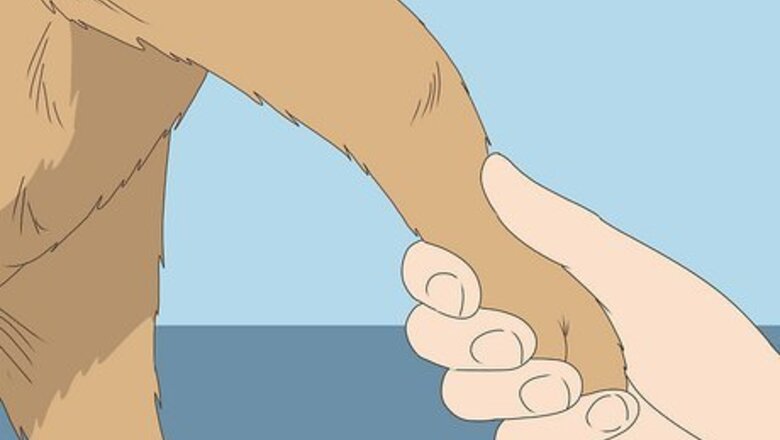
views
Determining the Limp’s Seriousness
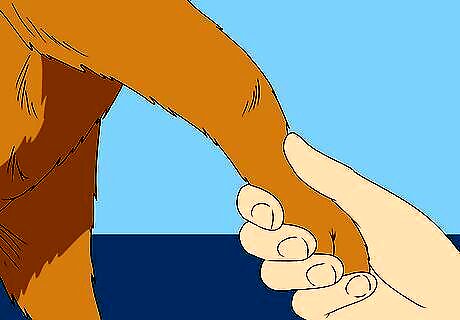
Look at your dog’s legs to see if there are signs of serious injury. If your dog has a dangling limb, protrusions from its leg, an unnaturally bent joint, or a severely crouched and hobbling stance, it’s a medical emergency, and you shouldn’t try to treat it at home. If there’s a lot of swelling or bleeding, a hot limb, or their leg isn’t supporting any weight, you should apply first aid using our tips and take them to an emergency clinic as soon as possible. Otherwise, follow our advice and call your vet when possible. If the injury is serious, contain your dog in a kennel or makeshift stretcher (tying them on a rug with a blanket) so they don’t injure themself further. Muzzle them if they could meddle with their injured leg and make it worse. Don’t try to hug or carry your dog if they’re in serious pain, like from a broken leg. Scared animals can be dangerous: when dogs are in pain, they are more likely to bite or scratch you. If you want to comfort them, speak to them soothingly or bring them comforting objects like blankets or toys. If a moderate limp persists more than a few days, it’s still a good idea to call the vet even if urgent symptoms aren’t present.
Treating Your Dog at Home

Sprained limb. Treat a sprained limb by wrapping an ice pack in a towel and holding it to the swollen area for ten to fifteen minutes at a time (between icing sessions, give your dog a break from the cold). On top of that, wrap the limb securely with bandages to secure the limb and prevent them from further injuring it. Keep them from running or moving fast by keeping them leashed and slow when they go outside. Signs of a sprained leg: If the limping came on suddenly and if your dog has a red and swollen joint, it could be a sprain. Take your dog to the vet to know for sure. A sprained limb is one of the most common causes of limping for dogs.
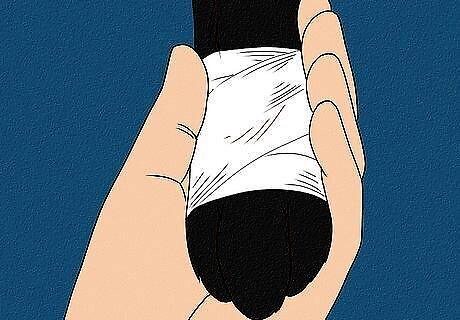
Wounded paw. If there's a cut on your dog's paw, run cool, clean water over the wound and remove any thorns, dirt, or glass in the cut. Then, put a bandage on it and apply pressure for at least three minutes, until the blood begins to clot and bleeding stops. Keep the wounded limb elevated to prevent excess bleeding. Then, apply an antibiotic and wrap gauze around the bandage to secure it. Signs of a cut paw: Identify a bleeding area by looking at their injured limb. Search their fur for blood, and look for a cut on the body part that the dog is limping on or licking. You might have to gently move their fur to identify where the cut is. Be careful when handling their injured limb. Your dog may lash out at you if you accidentally trigger pain, so make sure they’re relaxed and under control, and muzzled if possible.
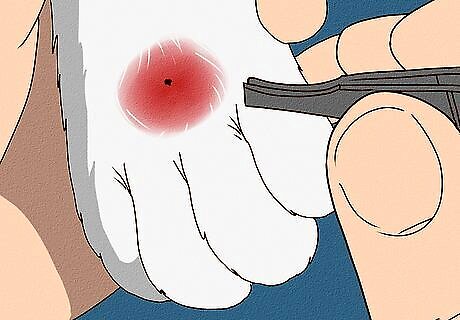
Insect bite or sting. If your dog has an insect bite or sting, use a credit card to scrape the stinger out or use tweezers to remove it. Then, apply an ice pack wrapped in a cloth to the site of the bite or sting to reduce swelling. Apply hydrocortisone cream or spray to reduce itching and swelling. Signs of an insect bite or sting: Look for a red swollen lump with small bite marks or a stinger on their paw or leg. If there’s no sign of a cut or infection, a red swollen lump on somewhere other than a joint is likely to be an insect bite or sting.
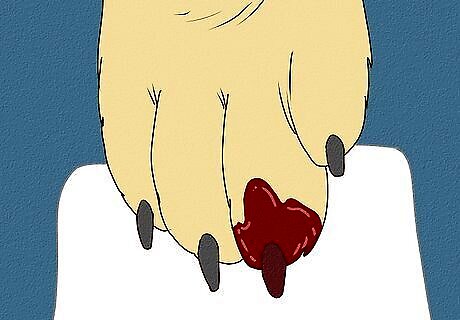
Torn nail. To treat a torn toenail, apply a clean bandage with pressure to stop the bleeding. Then, trim the part of the torn nail that’s still loosely hanging off (avoiding cutting too close to the nail bed). Then, soak the paw in warm soapy water, apply antibiotic ointment, and bandage and wrap the paw with clean gauze. Signs of a torn toenail: Look for blood coming from your dog’s paw and specifically from their nail bed. You’ll see a split nail or a part of the nail hanging off.
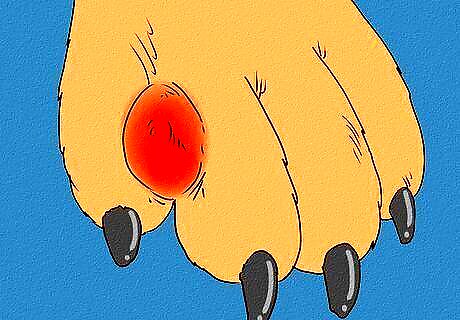
Abscess. If your dog has an abscess on their paw, apply a warm damp cloth or a microwavable warm compress to reduce swelling. Bandage the abscess so the dog doesn’t accidentally rupture it or infect it further. It’s best for a vet to deal with draining and cleaning an abscess. Signs of an abscess: Look for a pus-filled lump. An abscess will look like a warm red inflamed lump under the skin of a crusted-over wound, and there may be pus visible at the inflamed site. An abscess is an infected wound with a foul-smelling fluid inside. If absolutely necessary, you can drain the abscess on your own by lancing it with a disinfected needle and squeezing it until all the pus comes out. Gently clean the whole wound, including the inside, with an antiseptic soap. Then, apply an antibiotic to the whole wound and continue to clean it periodically as the wound heals. Disinfect all your tools and your hands before and after.
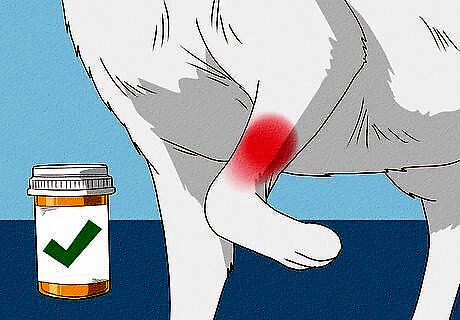
General leg pain and lameness. Do not give your dog any medication without calling your veterinarian. Your vet will tell you what kinds of painkillers you can give your dog and in what doses. Many human painkillers have negative side effects for dogs, so it’s important to get professional advice on pain medication for your dog. Once you’ve talked to your vet, follow their instructions to relieve your dog’s pain. EXPERT TIP Colleen Demling-Riley, CPDT-KA, CBCC-KA, CDBC Colleen Demling-Riley, CPDT-KA, CBCC-KA, CDBC Canine Behavior Consultant Colleen Demling-Riley (CPDT-KA, CBCC-KA, CDBC) is a Canine Behavior Consultant and the Founder of Pawtopia Dog Training. With more than 20 years of experience, she specializes in creating and customizing dog management programs for dog owners. She is a Certified Pet Dog Trainer-Knowledge Assessed, Certified Behavior Consultant Canine-Knowledge Assessed, Certified Dog Behavior Consultant, and American Kennel Club Canine Good Citizen Evaluator. Colleen is a member of the International Association of Canine Professionals and has been a featured expert in national media including the New York Times, Woman’s Day, Readers Digest, Cosmopolitan, and Yahoo.com. Colleen Demling-Riley, CPDT-KA, CBCC-KA, CDBC Colleen Demling-Riley, CPDT-KA, CBCC-KA, CDBC Canine Behavior Consultant Rest is essential for dogs with health issues. Make your dog as comfortable as possible with a soft bed in a quiet spot where they can rest peacefully. Limit your dog's activity, avoiding too much walking or play. This will prevent excess movement, which can cause infection or worsen their condition.
Medical Intervention for Serious Injuries

Take your dog to the vet or an emergency clinic if they have a serious injury. This includes signs of a broken or dislocated limb, a hip injury, or a ligament tear. Making a splint or sling for your dog at home can do more harm than good. Transport them to the clinic using a kennel or a makeshift stretcher, since picking your dog up manually could worsen the injury or provoke them. If you’re going to an emergency clinic, call ahead to let them know you’re coming.

If the limping has come on slowly and there are no other symptoms, seek a vet’s diagnosis. The cause could be a long-term disease. These include arthritis, osteosarcoma, Lyme disease, and dysplasia. You should take note of important symptoms to tell your vet, but these diseases are complex and only your vet will know how to spot them and treat them.

















Comments
0 comment